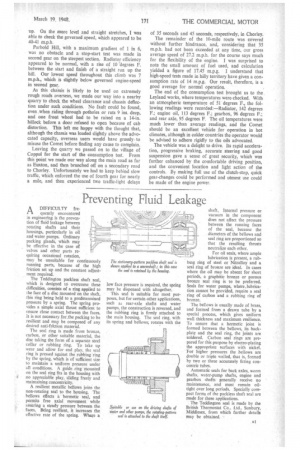Preventing Fluid Leakage
Page 35

If you've noticed an error in this article please click here to report it so we can fix it.
ADIFFICULTY frequently encountered in engineering is the prevention of fluid leakage between rotating shafts and their housings, particularly in oil and water pumps. Ordinary packing glands, which may be effective in the ease of valves and other parts requiring occasional rotation, may be unsuitable for continuously running parts, because of the high friction set up and the constant adjustment required.
The Teddington packless shaft seal, which is designed to overcome these difficulties, consists of a ring applied to the face of a disc mounted on the shaft, this ring being held to a predetermined pressure by a spring. The spring provides a simple axial thrust sufficient to ensure close contact between the faces. It is not necessary for.the packing to be resilient and may be composed of any desired anti-friction material.
The seal ring is made from bronze, carbon, or other suitable material, the disc taking the form of a separate steel collar or rubbing ring. To take up wear and allow for end play. the seal ring is pressed against the rubbing ring by the spring, which is of sufficient size to maintain a uniform pressure under all conditions. A guide ring mounted on the seal ring fits in the housing with no appreciable play, sliding freely and maintaining concentricity.
A resilient metallic bellows joins the non-rotating seal to the housing. The bellows effects a hermetic seal, and permits free axial movement while assuring a steady pressure between the faces. Being resilient, it increases the effective rate of the spring. Where a
low face pressure is required, the spring may be dispensed with altogether.
This seal is suitable for most purposes, but for certain other applications, such as rear-axle shafts and water pumps, the construction is reversed, and the rubbing ring is firmly attached to the main housing. The seal ring, with its spring and bellows; rotates with the shaft, Internal pressure or vacuum in the component does not affect the pressure between the running faces of the seal, because the diameters of the bellows and seal ring are proportioned so that the resulting thrusts neutralize each other.
For oil seals, where ample lubrication is present, a rubbing ring of steel or Nitralloy and a seal ring of bronze are ideal. In cases where the oil may be absent for short periods, a graphitic bronze or porous bronze seal ring is to be preferred. Seals for water pumps, where,lubricalion cannot be provided, require a seal ring of carbon and a rubbing ring of bronze.
The bellows is usually made of brass, and formed from a drawn tube by a special process, which gives uniform wall thickness and maximum resilience. To ensure that a hermetic joint is formed between the bellows, its backplate and the seal ring, the joints are Soldered. Carbon seal rings are prepared for this purpose by electro-plating the appropriate surfaces with nickel. For higher pressures the bellows are double or triple walled, that is, formed by two or three accurately fitting concentric tubes.
Automatic seals for back axles, worm shafts, water-pump shafts, engine and gearbox shafts generally receive no maintenance, and must remain oiltight over long periods. Specially compact forms of the packless shaft seal are made for these applications.
The Teddington seat is made by the British Thermostat Co., Ltd., Sunbury, Middlesex. from which further details may be obtained. •












































































